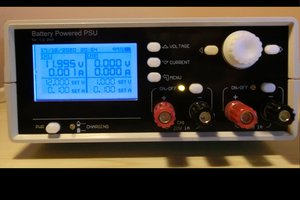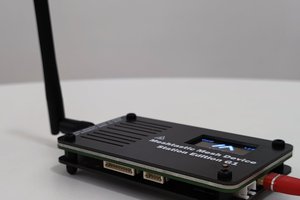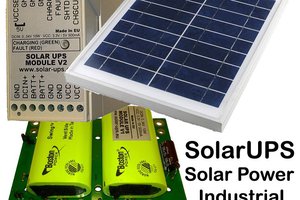If external power is connected to the tinyUPS the input voltage or vcc of the ATtiny13 is delivered by this source, otherwise by the battery. The ATtiny13 monitors the input voltage and tells the connected device to shutdown by pulling the SHUTDOWN-line low when the input voltage falls below a certain threshold (SHUTDOWNLEVEL). This happens when the external power source is diconnected or disabled and the battery level falls below this threshold. After waiting a certain time (SHUTDOWNTIMER) to allow the connected device to safely shut down, the ATtiny13 deactivates the boost converter and turns off the power to the connected device. If the input voltage rises again above a certain threshold (POWERONLEVEL) it activates the boost converter and turns on the power to the connected device. This happens when the external power source is available again. When power is turned on a BOOTUPTIMER starts to count. If a shutdown is initiated before the boot up is completed, the left-over time is added to the SHUTDOWNTIMER in order to allow the connected device to completely boot up and shut down. A shutdown can also be initiated by pressing and holding the button or by setting the REQUEST-line to high (>0.7V) for 2 seconds. After such shutdowns the power will not be turned on again automatically. The power to the connected device can be turned on manually by pressing the button or setting the REQUEST-line to high if the battery level is above a certain threshold (USERPOWERLEVEL) or the external power source is connected.
The SHUTDOWN pin of the tinyUPS is an open collector output. The connected device must have an internal or external pullup resistor on the SHUTDOWN line! This is necessary because of the different voltage levels.
The ATtiny13 spends most of the time in power-down sleep mode to save energy. The watch dog timer wakes it up every 8 seconds. It will also wake up if the button was pressed or the REQUEST-line was changed (pin change interrupt). After doing its stuff the ATtiny13 sleeps again. The current status of the tinyUPS is indicated by 5 LEDs:
| LED | State |
|---|---|
| VIN: on | external power is connected |
| CHARGE: on | battery is charging |
| FULL: on | battery is fully charged (is only shown if external power is connected) |
| STATUS: steady on | normal power-on operation |
| STATUS: blinking | in shutdown sequence |
| STATUS: short flashes | in standby (short flash occurs every 8 seconds) |
| VOUT: on | output power is turned on |
For battery charging the TP4056 is used. The TP4056 is a complete constant-current/constant-voltage linear charger for single cell lithium-ion batteries. The charge voltage is fixed at 4.2V and the charge current (max 1000mA) can be programmed externally with a single resistor (R3). The TP4056 automatically terminates the charge cycle when the charge current drops to 1/10th the programmed value after the final float voltage is reached. Other features include current monitor, under voltage lockout and automatic recharge.
For the battery protection (overcharge, overdischarge, overcurrent and short circuit protection) the DW01A is used in combination with two FS8205 dual MOSFETs in parallel. The DW01A is constantly measuring the voltage across the battery and the current flowing in (when charging) or coming out (when discharging). If something goes wrong it takes the battery out of the circuit by closing the MOSFETs which act like a switch between the negative side of the battery (B-) and ground. The overcurrent protection works by comparing the voltage drop across the MOSFET with the internal 150mV reference of the DW01A. As the RDS(on) of one FS8205 is around 2x25mOhm, the DW01A would close the MOSFET at 150mV/50mOhm = 3A if only one FS8205 were used. By using two FS8205 in parallel, the resistance is cut in half, so the DW01A shuts down at 150mV/25mOhm = 6A and one FS8205 must only handle half of the current (3A) which is well within its specs. In this way, up to 6 amps can flow from the battery into the boost converter with a maximum voltage drop of 150mV....
Read more » Stefan Wagner
Stefan Wagner



 Manuel Tosone
Manuel Tosone

 Gabor Futo
Gabor Futo
Hi, nice project. Do you think that a newer version based on 2x 14500 (AA size) LiOn/LiPoly batteries connected in parallel would be useful to create? Ideally the new TinyUPS v2.0 PCB should be sized as little as possible within the 14x14x50 mm volume constrain due to the batteries. This means to have the USB ports as optional. Ideally, it would work with just one 14500 inserted in such a way it would be possible and safe to replace one battery during power supply both by UPS or by external power. Moreover, it would be designed to be as cheaper as possible to produce (BOL: costs VS availability) and as simpler as possible to assembling (DIY friendly). Feel free to contact me in pvt ltgesv @ gmail . com